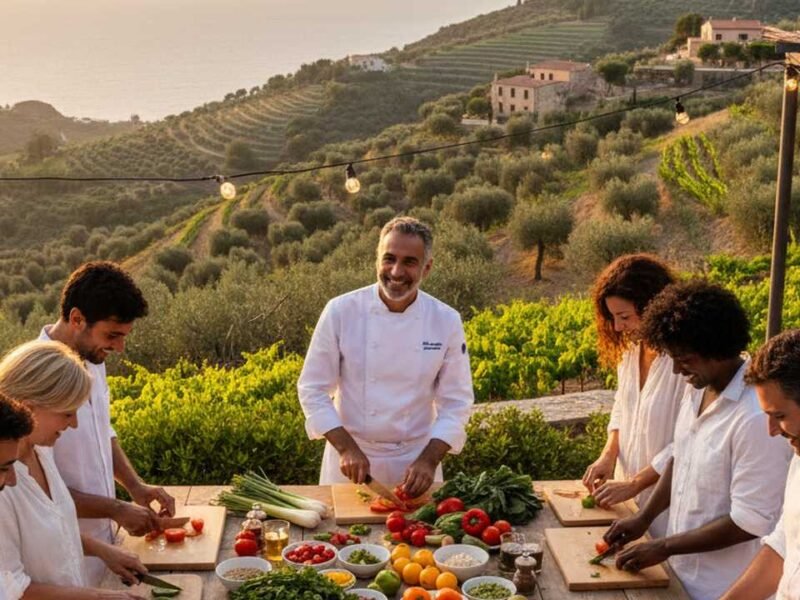Imagine stepping into a world where every meal tells a story, every street pulses with life, and every tradition is a living testament to resilience and heritage. Welcome to the vibrant tapestry of Somalia – a land where culinary delights, rich cultural heritage, and a dynamic lifestyle converge to create an unforgettable experience. If you’re seeking a destination that offers more than just picturesque landscapes, Somalia beckons with its unique blend of flavors, traditions, and stories waiting to be discovered.
1. The Culinary Delights of Somalia: A Feast for the Senses
Somali cuisine is a tantalizing fusion of flavors, textures, and aromas that reflect the country’s diverse history and cultural influences. From the bustling markets of Mogadishu to the coastal towns of Berbera, food is not just sustenance – it’s an experience. Picture yourself savoring a plate of bariis iskukaris, a fragrant rice dish infused with the earthy spices of xawaash, complemented by succulent goat meat and a side of spicy sambusas. The sweet and savory notes dance on your palate, leaving you craving more.
But the culinary journey doesn’t stop there. Indulge in canjeero, a spongy flatbread served with honey and ghee for breakfast, or enjoy a hearty bowl of maraq, a flavorful stew brimming with tender meat and vegetables. Each dish tells a story of Somalia’s rich agricultural heritage and the resourcefulness of its people. Whether you’re dining in a traditional restaurant or a humble street stall, the warmth and hospitality of the Somali people make every meal a celebration.
2. Somali Lifestyle: A Tapestry of Traditions and Modernity
In Somalia, the rhythm of daily life is a harmonious blend of ancient traditions and modern influences. The streets are alive with the sounds of commerce, conversation, and celebration. Women draped in colorful guntiino dresses and men in crisp white macawiis move gracefully through the markets, exchanging goods and stories. The air is filled with the scent of fresh spices, roasting coffee beans, and the sea breeze from the Indian Ocean.
Despite the challenges faced by the country, Somalia’s resilience shines through in its people’s unwavering commitment to community, family, and cultural preservation. Festivals like Id al-Fitr and Id al-Adha are celebrated with fervor, featuring traditional dances, music, and feasts that bring together families and communities. In urban centers like Mogadishu and Hargeisa, you’ll find a dynamic blend of old and new – modern cafes and shops nestled alongside historic buildings and bustling markets.
3. Cultural Heritage: A Living Legacy
Somalia’s cultural heritage is a rich tapestry woven from centuries of history, art, and tradition. The country’s oral storytelling tradition, known as sheeko, is a cornerstone of Somali culture, passed down through generations and performed in homes, markets, and public gatherings. These stories, often accompanied by traditional music and poetry, offer insights into Somalia’s values, history, and worldview.
Art and craftsmanship are also deeply embedded in Somali culture. From intricately woven baskets and colorful beadwork to the stunning architecture of ancient mosques and colonial-era buildings, Somali artisans showcase their skills and creativity in every piece. The Somali National Museum in Mogadishu houses a vast collection of artifacts, manuscripts, and artworks that chronicle the country’s rich history and cultural evolution.
4. Somali Architecture: A Blend of Tradition and Innovation
Somali architecture is a testament to the country’s rich history and cultural influences. Traditional Somali homes, known as aqal, are constructed using locally sourced materials such as palm fronds, mud, and thatch, designed to withstand the harsh climate and nomadic lifestyle. These structures are characterized by their circular shape, conical roofs, and open interiors, reflecting the Somali people’s deep connection to the land and their nomadic heritage.
In urban areas, Somali architecture has evolved to incorporate modern influences while retaining traditional elements. The skyline of Mogadishu features a mix of colonial-era buildings, Islamic architecture, and contemporary structures, creating a unique urban landscape. Notable landmarks include the Somali National Theatre, the Independence Monument, and the National Museum, each reflecting different periods of Somalia’s history and architectural development.
5. Somali Music and Dance: Rhythms of the Heart
Music and dance are integral to Somali culture, serving as expressions of joy, sorrow, and community. Traditional Somali music, characterized by its rhythmic beats and melodic vocals, is performed during various occasions, including weddings, festivals, and public celebrations. Instruments such as the oud (a stringed instrument), drums, and flutes accompany singers and dancers, creating an immersive auditory experience.
Dance forms like dhaanto and buraanbur are performed with energetic movements and synchronized steps, often telling stories or celebrating historical events. These dances are not just entertainment – they are a means of preserving history, expressing identity, and fostering community bonds. Participating in or witnessing these performances offers a deeper understanding of Somali culture and its vibrant traditions.
6. Somali Markets: A Sensory Overload
Stepping into a Somali market is like entering a world of sensory overload – vibrant colors, intoxicating aromas, and a cacophony of sounds. Markets in cities like Mogadishu, Hargeisa, and Kismayo are bustling hubs of activity, where vendors sell everything from fresh produce and spices to textiles and handcrafted goods. The air is filled with the scent of roasting meat, freshly baked bread, and the earthy aroma of spices like cumin, coriander, and cinnamon.
As you navigate through the narrow aisles, you’ll encounter a kaleidoscope of sights – piles of bright red tomatoes, golden turmeric roots, and vibrant fabrics draped over stalls. The sounds of bargaining and laughter echo through the air, creating an atmosphere of camaraderie and community. These markets are not just places to shop – they are living reflections of Somali culture, where tradition and commerce intersect.
7. Somali Landscapes: From Deserts to Coastlines
Somalia’s diverse landscapes offer a stunning contrast of natural beauty. From the arid deserts of the interior to the lush green hills of the north, and the pristine beaches along the Indian Ocean, the country’s geography is as varied as its culture. The Golis Mountains in the north provide a dramatic backdrop to the coastal plains, while the Shabelle River meanders through fertile valleys, supporting agriculture and wildlife.
The coastline stretches over 3,300 kilometers, offering some of the most beautiful and untouched beaches in Africa. Crystal-clear waters, white sandy shores, and vibrant coral reefs make Somalia a hidden gem for beach lovers and divers. Whether you’re exploring the ancient city of Zeila with its historical ruins or relaxing on the beaches of Berbera, Somalia’s landscapes offer a diverse range of experiences for nature enthusiasts and adventure seekers alike.
8. Somali Education: A Pathway to the Future
Education in Somalia is a vital component of the country’s development and future prosperity. Despite challenges such as limited resources, ongoing conflict, and gender disparities, significant strides have been made to improve access to education. The education system follows a 6-2-4-4 structure, encompassing six years of primary education, two years of lower secondary, four years of upper secondary, and four years of higher education. However, enrollment rates remain low, with only 22% of children completing primary school and even fewer progressing to secondary and tertiary levels.
Efforts are underway to address these challenges. Organizations like UNICEF and the Global Partnership for Education are working to increase enrollment, improve infrastructure, and train teachers. Initiatives focus on providing education to marginalized groups, including girls, children with disabilities, and those in rural areas. The establishment of institutions like the Iqra Institute for Higher Education in Badhan and the Indian Ocean University in Mogadishu are examples of local efforts to expand educational opportunities and empower the youth.
9. Somali Hospitality: Warm Welcomes Await
One of the most striking aspects of Somali culture is its hospitality. Visitors are welcomed with open arms, offered traditional drinks like shaah (tea) and camel milk, and invited to share in meals and stories. This warmth and generosity are deeply rooted in Somali values, where community and family are paramount. Whether you’re a guest in a rural village or a bustling city, you’ll find that Somali people take pride in making visitors feel at home.
Engaging with locals offers a unique opportunity to learn about the country’s history, traditions, and daily life. Many visitors find that their interactions with Somali people are among the most memorable aspects of their journey. These personal connections provide insights that go beyond guidebooks and offer a deeper understanding of the Somali way of life.
10. Why Somalia Should Be Your Next Travel Destination
Somalia is a destination that offers more than just tourist attractions – it provides an immersive experience into a rich and diverse culture. From the tantalizing flavors of Somali cuisine to the vibrant rhythms of traditional music and dance, every moment spent in Somalia is an opportunity to discover something new and meaningful. The country’s landscapes, history, and people create a tapestry of experiences that are both unique and unforgettable.
For those seeking adventure, cultural enrichment, and authentic connections, Somalia presents an opportunity to explore a country that is often overlooked by mainstream tourism. By visiting, you not only experience its beauty and heritage but also contribute to the country’s economic development and cultural preservation. Don’t miss the chance to be part of Somalia’s journey – plan your visit today and discover the treasures that await.

